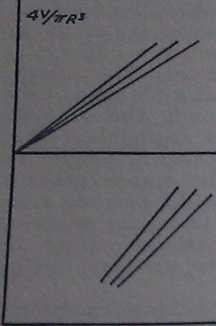49805 str (123)

THE SIGMA PHENOMENON
34
and Scott Blair to test the effect of using ^ differences in radius and length. The length eft^ was not found to be significant ; but changes in radius make a very big difference for clays, and Jebens has found the same thing for water paints, The smaller the tubę, the greater the mobility appearś to be.
There are, therefore, four possibilities, as shown in Fig. 8 :—

23lair)
Kio. 8. (After Schofiold and Scott
''fij
Ali these have been realised e.Kperime11 , 'v'fl I clays at suitable concentration, except is a curve for a true fluid, such as glycef
No. i shows “ spread,” but there is y * I the materiał behaves as a true fluid, f°l capillary. over a wide pressure rangę.
No. :2 shows “ spread and intercep
No. 3 shows neither spread nor intercept (a true fluid).
No. 4 shows intercept, but no spread {a simple Buckingham-Reiner materiał).
This means that the viscosities of certain industrial materials, even when reproduced at a senes of stresses, may be in error by as much as 50 per cent., which is serious. It is not yet fully known how one is to correct for this effect, or to what it is due ; but the following treatment is suggested. Suppose that V/ttR2 is plotted against PR/2L, where V/ttR2 is the mean velocity, we get a series of curves of slope d(V/ttR2)jd(PR/2L). This slope will be called a. In the case of a true fluid, if 1 is plotted against R, a straight linę is obtained, passing through the origin and having a slope of \<f>. For these clays, the curve is fairly linear over a reasonable rangę, but it makes an intercept on the a axis, which will be called Oo. The slope of this curve gives a value of mobility which would be the limiting value for an infinite radius.
This work has been done chiefly on clays, but it is eąually applicable to quite a number of rheologically similar materials, such as some paints, tooth-pastes, talc-suspensions, suspensions of insoluble precipi-tates, and of course, such things as soils and drilling muds. Othor treatments have been suggested, but the one deseribed seems reully to be the most, satisfactory, although the physical basis tur it is meagre, t he suggestion of Aiubrose and Loomis that the effect is due to thisotropy 1 (i.*., a lower cunsistoney iu the uurrowor tubes, where the sheur >s greuter) is invuUdated Iły the lad that an ineteused length ot tubo iucreases the amouut of shear, without affaoting the eonsisteney. It is
1 Vi4» VIII, rhlliepull dnu oiitloluwł aml tninulu
ll'l# Ukhmv (witł# i>. Si),
Wyszukiwarka
Podobne podstrony:
Tax expenditures: spending through the Polish tax system 97 Tablc 2. Size and fiscal effects of tax
258 Arquivos de Zoologia The resuit of only one tree demonstrates the high degree of morphological d
The Monster Detal screen altowa you to see a cłetaitod desolptton of mery monster in the
Relating to skills: PEK_U01 — is capable to provide an analysis of simple networks in time domain an
150 Boskey, A. L., F. H. Wians Jr. et P. V. Hauschka (1985). The effect of osteocalcin on in vitro l
24 Yeronica Franco and poor in invention and language, to dedicate to you this volume of letters wri
New?ventures Pre Itermediate Teacher s Book testy Test 4 str 2 7 Complete the sentences. Use just a
10 123. The Problem of Sensitive and Critical Periods in Motor
cp 34 What inspiration U thcrc to betler and dcancr methods of life. in the spectaclc of a musde-bou
Untitled 34 DAISY CHAIN -
New?ventures Elementary Teacher s Book testy Unit 5 Test str 2 5 Complete the dialogue. Use the cor
Grammar 9 TASK 4 What is the difference in meaning between (a) and (b) below? la My brother, who is
00014 L28ee5aa5f5654405d1c5056d87a4de 13 An Overview and Perspective on Control Charting enough to
00177 M99912f12e6330c3ed1d7a7b02348c6 178McWilliams Table 5B. Effect of Adding the Constralnt a ś 0
więcej podobnych podstron